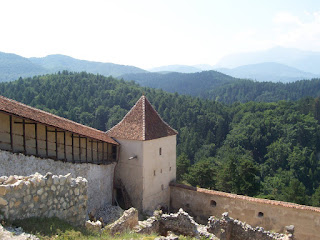Rasnov and Bran Castle
Last Saturday, my classmates and professors from the language program and I took a field trip to some nearby tourist attractions. We visited a medieval fortress in the village of Rasnov and Bran Castle, which is often referred to as Dracula's castle. The Rasnov fortress was built around 1215 on a hill between three villages along an important trading route. The idea was that if the area was attacked, many of the people and the livestock from the three surrounding villages could take shelter there while the soldiers defended the citadel.
According to local mythology, the well in the citadel was dug by two Turkish prisoners. They assumed that after completing the well, they would be given their freedom. Instead, when the well was completed after 17 years of hard work, they were killed. The name of the fortress comes from the German word for 'rose' because, like many old villages and cities in Transylvania, Rasnov was founded by Saxons (German-speakers who later converted to Lutheranism).
 Rasnov Fortress
Rasnov Fortress
 The chapel in the fortress
The chapel in the fortress
 A view of the town of Rasnov from the citadel
A view of the town of Rasnov from the citadel
Next, we visited Bran Castle, which, I'm sorry to inform you, has no connection to Dracula whatsoever. The castle was built in the thirteenth century by the Saxons of Brasov (or Kronstadt as it is known in German). Brasov is located on the border between Transylvania, which was part of the Austro-Hungarian Empire, and Wallachia, which was sometimes independent and sometimes a tributary state to the Ottoman Empire (based in Turkey). Therefore it was a strategic location for both warfare and commerce. Bran castle was originally a fortress used to defend Transylvania from the Turks, and it was later used as a customs post, where merchants crossing between Wallachia and Transylvania had to stop and pay a fine.
In the early twentieth century, the people of Bran gave the castle to Romania's beloved Queen Marie. The castle was the summer home of the royal family until the communist takeover in 1948. It was recently returned to the royal family and now belongs to the heir of Queen Marie's daughter, Archduke Dominic of Austria, who is an architect in New York.
Vlad Tepes (or Vlad the Impaler), the Wallachian prince who is rumered to have been the inspiration for Bram Stoker's book Dracula , never lived at Bran Castle, and no one knows for sure if he ever visited it. As far as I can tell, it was chosen as "Dracula's Castle" because it is a well preserved medieval castle in Transylvania. In order to capitalize on certain tourists' vampire obsessions, a lot of Dracula-related tourist traps have sprung up around the castle.
 Bran Castle from across the valley
Bran Castle from across the valley
 The central courtyard and tower of the castle
The central courtyard and tower of the castle

 Me sitting in front a window with a great view
Me sitting in front a window with a great view




 Wishing well in the courtyard
Wishing well in the courtyard
 A particularly amusing bit of vampire kitsch
A particularly amusing bit of vampire kitsch
According to local mythology, the well in the citadel was dug by two Turkish prisoners. They assumed that after completing the well, they would be given their freedom. Instead, when the well was completed after 17 years of hard work, they were killed. The name of the fortress comes from the German word for 'rose' because, like many old villages and cities in Transylvania, Rasnov was founded by Saxons (German-speakers who later converted to Lutheranism).
 Rasnov Fortress
Rasnov Fortress The chapel in the fortress
The chapel in the fortress A view of the town of Rasnov from the citadel
A view of the town of Rasnov from the citadel Next, we visited Bran Castle, which, I'm sorry to inform you, has no connection to Dracula whatsoever. The castle was built in the thirteenth century by the Saxons of Brasov (or Kronstadt as it is known in German). Brasov is located on the border between Transylvania, which was part of the Austro-Hungarian Empire, and Wallachia, which was sometimes independent and sometimes a tributary state to the Ottoman Empire (based in Turkey). Therefore it was a strategic location for both warfare and commerce. Bran castle was originally a fortress used to defend Transylvania from the Turks, and it was later used as a customs post, where merchants crossing between Wallachia and Transylvania had to stop and pay a fine.
In the early twentieth century, the people of Bran gave the castle to Romania's beloved Queen Marie. The castle was the summer home of the royal family until the communist takeover in 1948. It was recently returned to the royal family and now belongs to the heir of Queen Marie's daughter, Archduke Dominic of Austria, who is an architect in New York.
Vlad Tepes (or Vlad the Impaler), the Wallachian prince who is rumered to have been the inspiration for Bram Stoker's book Dracula , never lived at Bran Castle, and no one knows for sure if he ever visited it. As far as I can tell, it was chosen as "Dracula's Castle" because it is a well preserved medieval castle in Transylvania. In order to capitalize on certain tourists' vampire obsessions, a lot of Dracula-related tourist traps have sprung up around the castle.
 Bran Castle from across the valley
Bran Castle from across the valley The central courtyard and tower of the castle
The central courtyard and tower of the castle
 Me sitting in front a window with a great view
Me sitting in front a window with a great view



 Wishing well in the courtyard
Wishing well in the courtyard A particularly amusing bit of vampire kitsch
A particularly amusing bit of vampire kitsch
















































